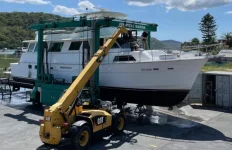scottinsydney
Well-known member
- Joined
- Jul 23, 2014
- Messages
- 897
- Status
- OWNER - I own a Hatteras Yacht
- Hatteras Model
- 61' MOTOR YACHT (1980 - 1985)
Hello All, This is a new thread about achieving the goals of DC power
for existing aircons for our Antipodean Big Loop trip. Its not about the pros and cons of lithium batteries.
++
Following on from the 2021 lithium battery installation we'll now power the OSR, galley and twin cabin air cons via an inverter. There would be a switch somewhere to select Generator or Inverter power for these three units. The Victron lithium system is fantastic reducing genset usage by 75% so far and we have our "silent ship."
The purpose of all this is to have aircon available at night and sometimes during the day without running the noisy generator.
This is all part of the 2025 bucket list plan to go up to the Great Barrier Reef, on to Papua New Guinea and across to New Caledonia. The Admiral is in favour of getting me out of the house and already declared herself to be a FIFO wife... Fly In Fly Out. Kids will be in last years of school and holiday adventures await them.
It seems that moving to a 10,000 or 15,000 watt inverter and doubling or tripling the size of the lithium battery bank to a minimum of 400 or 600 amps at 48 volts (20kwh or 30 kwh hours) will provide enough power to get though a hot humid night. The solar farm on the flybridge roof will average 6300 watt hours a day.* Genset would still need to run to charge batteries.
The seven old Cruisair units may not be as energy efficient as newer units, but they are installed and working. Two aircons and pumps operating should use 10 Amps at 240 volts when compressors are running. The total cost of two additional custom made batteries is about US$8500 which will be less expensive overall and simpler than installing new or additional aircons. Plus the cost of the larger inverter.
On a hot day we could also run the galley aircon to take the sting out of the galley, wheelhouse and salon. We can also run the genset if we need to really cool the boat down. Big dehumidifiers will also work too.
So these are our initial thoughts and work could be completed by November. Does anyone have any comments about the plan or its execution?
*Apologies if I have my wh and kwh nomenclature incorrectly termed.
for existing aircons for our Antipodean Big Loop trip. Its not about the pros and cons of lithium batteries.
++
Following on from the 2021 lithium battery installation we'll now power the OSR, galley and twin cabin air cons via an inverter. There would be a switch somewhere to select Generator or Inverter power for these three units. The Victron lithium system is fantastic reducing genset usage by 75% so far and we have our "silent ship."
The purpose of all this is to have aircon available at night and sometimes during the day without running the noisy generator.
This is all part of the 2025 bucket list plan to go up to the Great Barrier Reef, on to Papua New Guinea and across to New Caledonia. The Admiral is in favour of getting me out of the house and already declared herself to be a FIFO wife... Fly In Fly Out. Kids will be in last years of school and holiday adventures await them.
It seems that moving to a 10,000 or 15,000 watt inverter and doubling or tripling the size of the lithium battery bank to a minimum of 400 or 600 amps at 48 volts (20kwh or 30 kwh hours) will provide enough power to get though a hot humid night. The solar farm on the flybridge roof will average 6300 watt hours a day.* Genset would still need to run to charge batteries.
The seven old Cruisair units may not be as energy efficient as newer units, but they are installed and working. Two aircons and pumps operating should use 10 Amps at 240 volts when compressors are running. The total cost of two additional custom made batteries is about US$8500 which will be less expensive overall and simpler than installing new or additional aircons. Plus the cost of the larger inverter.
On a hot day we could also run the galley aircon to take the sting out of the galley, wheelhouse and salon. We can also run the genset if we need to really cool the boat down. Big dehumidifiers will also work too.
So these are our initial thoughts and work could be completed by November. Does anyone have any comments about the plan or its execution?
*Apologies if I have my wh and kwh nomenclature incorrectly termed.
Last edited:



